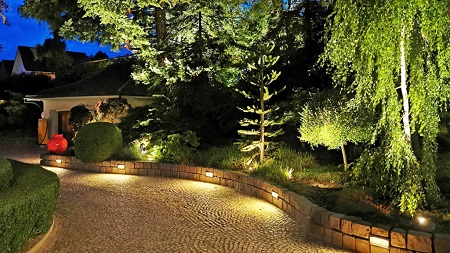When it comes to designing a garden, lighting is often overlooked, but it is a crucial aspect that can make a significant impact on the overall aesthetics and safety of your outdoor space. A well-designed garden lighting system can transform your garden into a stunning nighttime oasis, while also providing safety and security for you and your guests. In this article, we’ll cover everything you need to know to create a beautiful and safe outdoor space with garden lighting.
Understanding Garden Lighting Design
Before we dive into the tips and tricks for designing garden lighting, it’s essential to understand the basics of garden lighting design. The main types of garden lighting are ambient, task, and accent lighting. Ambient lighting provides general illumination for your garden, while task lighting is used to light specific areas, such as walkways and stairs. Accent lighting is used to highlight specific features of your garden, such as a beautiful tree or water feature.
Choosing the Right Garden Lighting Fixtures
Choosing the right lighting fixtures is crucial to achieving the desired effect in your garden. There are several types of fixtures to choose from, including:
- Pathway lights: Used to illuminate walkways and stairs, pathway lights come in a variety of styles and heights to match your garden’s aesthetics.
- Spotlights: Ideal for accent lighting, spotlights can be used to highlight specific garden features, such as sculptures or water features.
- Floodlights: Used for security and safety, floodlights provide a bright and broad illumination to deter intruders and ensure safety in your outdoor space.
- Wall lights: Mounted on walls, these lights are great for adding ambiance and safety to your garden.
- String lights: Perfect for creating a festive atmosphere, string lights can be hung across your garden or wrapped around trees and bushes.
Creating a Garden Lighting Plan
Once you have chosen the right lighting fixtures, it’s time to create a lighting plan for your garden. A well-designed lighting plan should include a combination of ambient, task, and accent lighting. Here are some tips to consider when creating a garden lighting plan:
- Determine the areas of your garden that need lighting: Identify the areas of your garden that require lighting, such as walkways, stairs, sitting areas, and garden features.
- Decide on the type of lighting needed: Based on the areas you have identified, choose the type of lighting that is best suited for each location.
- Determine the right height for your fixtures: The height of your fixtures can greatly affect the ambiance and overall look of your garden, so it’s essential to choose the right height for each fixture.
- Choose the right bulbs: The type of bulbs you choose can affect the color temperature and brightness of your garden lighting, so be sure to choose bulbs that match your desired ambiance.
Read more: Vegetable Garden Design
Installing Garden Lighting
Now that you have a lighting plan, it’s time to install your garden lighting fixtures. Here are some tips to consider when installing garden lighting:
- Hire a professional: While it’s possible to install garden lighting on your own, it’s always best to hire a professional to ensure that your lighting is installed safely and correctly.
- Use waterproof fixtures: Outdoor lighting fixtures should be waterproof to protect against the elements and ensure longevity.
- Use energy-efficient bulbs: Energy-efficient bulbs can save you money on your energy bill while also being better for the environment.
- Test your lighting system: Before finalizing your lighting installation, be sure to test your system to ensure that everything is working correctly.
Maintaining Garden Lighting
Once your garden lighting is installed, it’s essential to maintain it to ensure that it continues to function correctly and look great. Here are some tips to consider when maintaining your garden lighting:
- Clean your fixtures regularly: Dirt and debris can build up on your fixtures, so be sure to clean them regularly to maintain their appearance and functionality.
- Replace bulbs when necessary: If a bulb burns out, be sure to replace it promptly to maintain the overall lighting design and safety of your outdoor space.
- Check for damage: Regularly inspect your lighting fixtures for any signs of damage, such as cracks or corrosion, and replace or repair as necessary.
Safety Considerations for Garden Lighting
Safety should always be a top priority when it comes to designing and installing garden lighting. Here are some safety considerations to keep in mind:
- Use low-voltage lighting: Low-voltage lighting is safer than high-voltage lighting and reduces the risk of electrical shock.
- Use fixtures that are rated for outdoor use: Indoor lighting fixtures are not designed for outdoor use and can be dangerous when exposed to the elements.
- Ensure that wiring is buried properly: Exposed wiring can pose a safety hazard, so be sure to bury wiring properly to ensure safety.
- Use motion sensor lighting for added security: Motion sensor lighting can help deter intruders and provide added security for your outdoor space.
Conclusion
Garden lighting design is an important aspect of creating a beautiful and safe outdoor space. By understanding the basics of garden lighting design, choosing the right lighting fixtures, creating a lighting plan, installing garden lighting safely, and maintaining your lighting system, you can transform your garden into a stunning nighttime oasis. Remember to always prioritize safety when designing and installing garden lighting to ensure that your outdoor space is not only beautiful but also safe for you and your guests.
